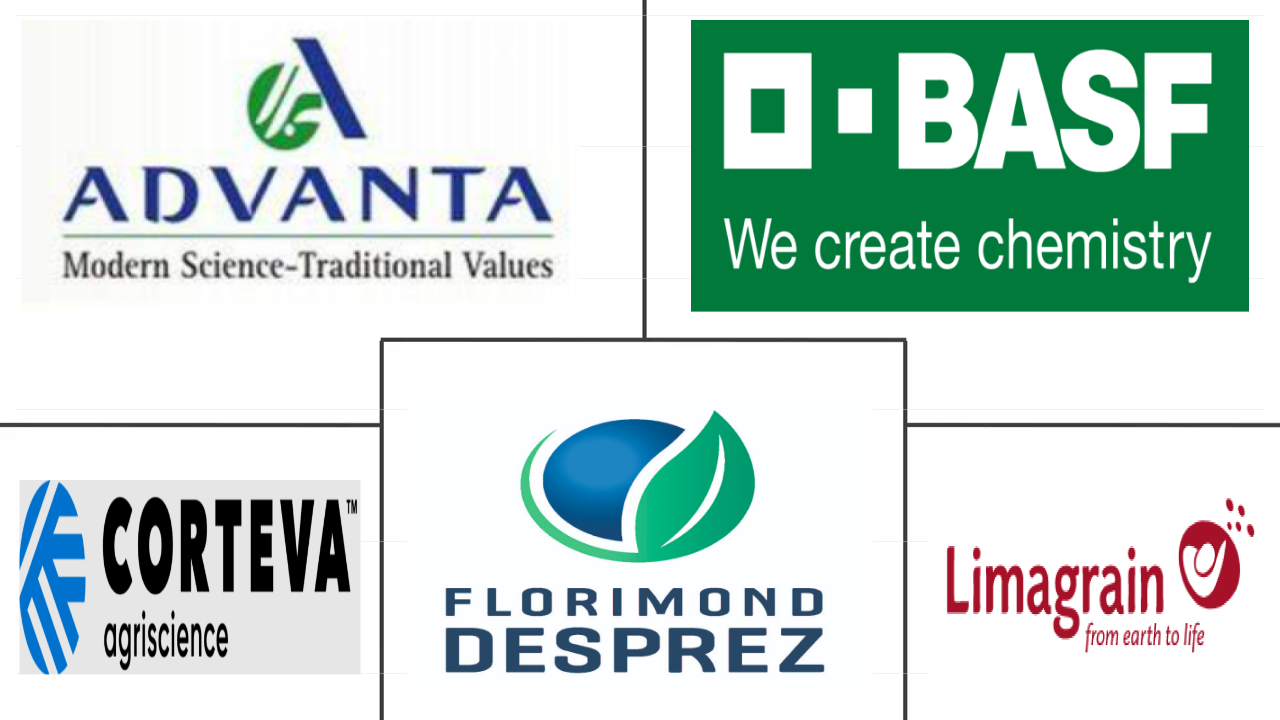Market Size of wheat seed Industry
|
|
Study Period | 2017 - 2030 |
|
|
Market Size (2024) | USD 6.03 Billion |
|
|
Market Size (2030) | USD 8.38 Billion |
|
|
Largest Share by Breeding Technology | Open Pollinated Varieties & Hybrid Derivatives |
|
|
CAGR (2024 - 2030) | 5.64 % |
|
|
Largest Share by Region | Europe |
Major Players |
||

|
||
|
*Disclaimer: Major Players sorted in no particular order |
Wheat Seed Market Analysis
The Wheat Seed Market size is estimated at 6.03 billion USD in 2024, and is expected to reach 8.38 billion USD by 2030, growing at a CAGR of 5.64% during the forecast period (2024-2030).
6.03 Billion
Market Size in 2024 (USD)
8.38 Billion
Market Size in 2030 (USD)
8.87 %
CAGR (2017-2023)
5.64 %
CAGR (2024-2030)
Largest Market by Breeding Technology
94.96 %
value share, Open Pollinated Varieties & Hybrid Derivatives, 2023
Open-pollinated varieties require fewer inputs, such as fertilizer and pesticides, are less expensive than hybrid seeds, and are more affordable for low-income farmers.
Largest Market by Country
20.37 %
value share, United States, 2023
The United States is the fourth-largest producer of wheat globally. It has increased the cultivation of wheat due to an increase in price and an increase in global demand.
Fastest-growing Market by Breeding Technology
6.65 %
Projected CAGR, Hybrids, 2024-2030
It is expected to increase in the future as there are a few hybrids available, and companies are developing new hybrids with drought tolerance and disease resistance traits.
Fastest-growing Market by Country
10.75 %
Projected CAGR, Brazil, 2024-2030
The rapid growth of Brazil is associated with the quick adoption of modern technologies (HB4 wheat) to meet the increasing demand in the domestic and international markets.
Leading Market Player
7.17 %
market share, BASF SE, 2022

BASF SE is the market leader due to the company launching new products, using better technology for production (Ideltis), and partnering with other players to develop new products.
Open pollinated varieties dominated the global wheat seed market
- Globally, in 2022, open pollinated varieties and hybrid derivatives accounted for 9% of the wheat seed market, as it is largely used for cultivation across the globe due to OPV being self-pollinated and the lower cost of open-pollinated seed varieties. In 2022, North America was the largest region using open-pollinated varieties and hybrid derivatives for the cultivation of wheat, accounting for 25% of the global wheat seed market. This is associated with the affordability and high availability of OPVs in the world.
- Brazil and Spain are the fastest-growing countries in the global OPV wheat seed market. Both countries are projected to register a CAGR of 10.7% and 8.4% during the forecast period due to the demand from farmers and the increase in the demand for wheat from international markets.
- Globally, hybrids accounted for only 5% of the total wheat seed market in 2022, which is projected to increase by 58% by 2030 due to the increase in the demand for high-yielding and input-efficient seed varieties. Hybrid seeds can produce a 40% higher yield per hectare, which will help in the growth of the hybrid seed segment in Asia-Pacific. In 2022, among hybrids, non-transgenic wheat seeds accounted for about 95.4% of the global wheat seed market, whereas transgenic seeds accounted for 4.5% of the global hybrid wheat seed market. Recently, in 2022, Argentina and Brazil approved the cultivation of transgenic wheat (HB4) drought-tolerant varieties.
- Open pollinated varieties require fewer inputs, such as fertilizers and pesticides, and they are more affordable for low-income farmers, which is projected to drive the OPV wheat seed market during the forecast period with a CAGR of 5.6%.
High consumption demand of wheat and lower investment are factors driving the market growth
- In 2022, wheat seed market accounted for 8.2% of the global seed market value. The wheat seed market value increased by 57.8% between 2017 and 2022. Europe was the largest wheat producer globally. It accounted for a 45.3% share of the global wheat seed market. France, Germany, the United Kingdom, Ukraine, and Russia held the largest share in the region, together accounted for 30.1% of the global wheat seed market in 2022.
- In 2022, the United States held a market share of 20.3% of the global wheat seed market due to higher seed storage and high ROI, as open-pollinated seed varieties are used more than hybrid seeds.
- The South American hybrid wheat seed market is anticipated to grow at a CAGR of 9.9% during the forecast period due to the increased cultivation area and the global demand for wheat. The wheat cultivation area in South America increased by more than 22% between 2017 and 2022 as more OPVs were used to produce wheat in large quantities to meet the global demand.
- South American growers are estimated to cultivate more wheat to compensate for the deficit in production and demand due to the Ukraine-Russia war. Argentina is the primary South American producer and exporter of wheat, accounting for about 7% of the global exports in 2022.
- The usage of OPVs in wheat is higher as they are more affordable than hybrids and can be saved for the next crop season. Thus, growers can have a higher ROI as less investment is required for seeds due to the lower price of OPVs than hybrid seeds.
- Thus, the high consumption of wheat and lower investment are likely to boost the wheat segment's growth during the forecast period at a CAGR of 5.6%.
Wheat Seed Industry Segmentation
Hybrids, Open Pollinated Varieties & Hybrid Derivatives are covered as segments by Breeding Technology. Africa, Asia-Pacific, Europe, Middle East, North America, South America are covered as segments by Region.
- Globally, in 2022, open pollinated varieties and hybrid derivatives accounted for 9% of the wheat seed market, as it is largely used for cultivation across the globe due to OPV being self-pollinated and the lower cost of open-pollinated seed varieties. In 2022, North America was the largest region using open-pollinated varieties and hybrid derivatives for the cultivation of wheat, accounting for 25% of the global wheat seed market. This is associated with the affordability and high availability of OPVs in the world.
- Brazil and Spain are the fastest-growing countries in the global OPV wheat seed market. Both countries are projected to register a CAGR of 10.7% and 8.4% during the forecast period due to the demand from farmers and the increase in the demand for wheat from international markets.
- Globally, hybrids accounted for only 5% of the total wheat seed market in 2022, which is projected to increase by 58% by 2030 due to the increase in the demand for high-yielding and input-efficient seed varieties. Hybrid seeds can produce a 40% higher yield per hectare, which will help in the growth of the hybrid seed segment in Asia-Pacific. In 2022, among hybrids, non-transgenic wheat seeds accounted for about 95.4% of the global wheat seed market, whereas transgenic seeds accounted for 4.5% of the global hybrid wheat seed market. Recently, in 2022, Argentina and Brazil approved the cultivation of transgenic wheat (HB4) drought-tolerant varieties.
- Open pollinated varieties require fewer inputs, such as fertilizers and pesticides, and they are more affordable for low-income farmers, which is projected to drive the OPV wheat seed market during the forecast period with a CAGR of 5.6%.
| Breeding Technology | ||||||
| ||||||
| Open Pollinated Varieties & Hybrid Derivatives |
| Region | |||||||||||||||||
| |||||||||||||||||
| |||||||||||||||||
| |||||||||||||||||
| |||||||||||||||||
| |||||||||||||||||
|
Wheat Seed Market Size Summary
The wheat seed market is poised for significant growth, driven by increasing global demand for wheat as a staple food and the need for high-yielding, disease-resistant varieties. The market is characterized by a diverse range of seed types, including open-pollinated varieties (OPVs) and hybrids, with OPVs being particularly popular due to their affordability and lower input requirements. North America leads in the use of OPVs, while countries like Brazil and Spain are emerging as fast-growing markets for these seeds. The hybrid seed segment is expected to expand, especially in the Asia-Pacific region, due to the demand for seeds that offer higher yields and better input efficiency. The approval of transgenic wheat varieties in countries like Argentina and Brazil further underscores the evolving landscape of the wheat seed market.
The market's growth is also supported by the increasing acreage under wheat cultivation, particularly in regions such as Asia-Pacific and Europe, where favorable climatic conditions and high domestic demand drive production. The United States and South America are key players in the global wheat production scene, with South America experiencing a surge in cultivation area to meet international demand. The market is fragmented, with major companies like Advanta Seeds - UPL, BASF SE, Corteva Agriscience, Florimond Desprez, and Groupe Limagrain leading the charge in developing innovative seed varieties. These companies are focusing on traits such as disease resistance and yield improvement to cater to the evolving needs of farmers worldwide. As research and development in stress-tolerant and disease-resistant varieties continue, the wheat seed market is expected to witness robust growth in the coming years.
Wheat Seed Market Size - Table of Contents
-
1. MARKET SEGMENTATION (includes market size in Value in USD, Forecasts up to 2030 and analysis of growth prospects)
-
1.1 Breeding Technology
-
1.1.1 Hybrids
-
1.1.1.1 Non-Transgenic Hybrids
-
1.1.1.2 Transgenic Hybrids
-
1.1.1.2.1 Other Traits
-
-
-
1.1.2 Open Pollinated Varieties & Hybrid Derivatives
-
-
1.2 Region
-
1.2.1 Africa
-
1.2.1.1 By Breeding Technology
-
1.2.1.2 By Country
-
1.2.1.2.1 Egypt
-
1.2.1.2.2 Ethiopia
-
1.2.1.2.3 Kenya
-
1.2.1.2.4 Nigeria
-
1.2.1.2.5 South Africa
-
1.2.1.2.6 Tanzania
-
1.2.1.2.7 Rest of Africa
-
-
-
1.2.2 Asia-Pacific
-
1.2.2.1 By Breeding Technology
-
1.2.2.2 By Country
-
1.2.2.2.1 Australia
-
1.2.2.2.2 Bangladesh
-
1.2.2.2.3 China
-
1.2.2.2.4 India
-
1.2.2.2.5 Japan
-
1.2.2.2.6 Myanmar
-
1.2.2.2.7 Pakistan
-
1.2.2.2.8 Thailand
-
1.2.2.2.9 Rest of Asia-Pacific
-
-
-
1.2.3 Europe
-
1.2.3.1 By Breeding Technology
-
1.2.3.2 By Country
-
1.2.3.2.1 France
-
1.2.3.2.2 Germany
-
1.2.3.2.3 Italy
-
1.2.3.2.4 Netherlands
-
1.2.3.2.5 Poland
-
1.2.3.2.6 Romania
-
1.2.3.2.7 Russia
-
1.2.3.2.8 Spain
-
1.2.3.2.9 Turkey
-
1.2.3.2.10 Ukraine
-
1.2.3.2.11 United Kingdom
-
1.2.3.2.12 Rest of Europe
-
-
-
1.2.4 Middle East
-
1.2.4.1 By Breeding Technology
-
1.2.4.2 By Country
-
1.2.4.2.1 Iran
-
1.2.4.2.2 Saudi Arabia
-
1.2.4.2.3 Rest of Middle East
-
-
-
1.2.5 North America
-
1.2.5.1 By Breeding Technology
-
1.2.5.2 By Country
-
1.2.5.2.1 Canada
-
1.2.5.2.2 Mexico
-
1.2.5.2.3 United States
-
1.2.5.2.4 Rest of North America
-
-
-
1.2.6 South America
-
1.2.6.1 By Breeding Technology
-
1.2.6.2 By Country
-
1.2.6.2.1 Argentina
-
1.2.6.2.2 Brazil
-
1.2.6.2.3 Rest of South America
-
-
-
-
Wheat Seed Market Size FAQs
How big is the Global Wheat Seed Market?
The Global Wheat Seed Market size is expected to reach USD 6.03 billion in 2024 and grow at a CAGR of 5.64% to reach USD 8.38 billion by 2030.
What is the current Global Wheat Seed Market size?
In 2024, the Global Wheat Seed Market size is expected to reach USD 6.03 billion.

